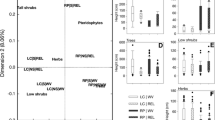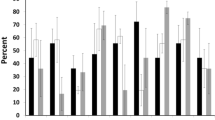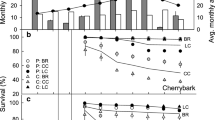Abstract
The survival of bare-root and container-grown loblolly pine (Pinus taeda L.) seedlings exceeded 90% when outplanted in March at two sites in Lee County, Alabama. At both sites, soil moisture and seedling survival were greater in March than in May. A March herbicide application reduced weed biomass by 75–80% at both sites. At the moist site, herbicide application did not affect survival. However, at the drier site, a reduction in weed biomass increased both the percent soil moisture and the survival of May-planted bare-root seedlings. When soil moisture at planting time was less than 13% on a dry weight basis container-grown seedlings survived better than bare-root seedlings. At both sites, reduced weed competition resulted in greater seedling heights and diameters.
Similar content being viewed by others
References
Alm A.A. (1974) Pine tubeling survival varies with vegetative competition. Tree Planters' Notes 25(1):33–36.
Arnott J.T. (1975) Field performance of container grown and bare-root trees in coastal British Columbia. Can. J. For. Res. 5:186–194.
Barnett J.P. (1983) containerized pine seedlings for revegetating difficult sites. J. Soil and Water Conservation 38:462–464.
Barnett J.P. (1984) Relating seedling physiology to survival and growth in container-grown southern pines. In Seedling physiology and reforestation success, M.L. Duryea and G.N. Brown, eds. Martinus Nijhoff/Dr W. Junk Publishers, Dordrecht, The Netherlands. p. 157–176.
Bilan, M.V. (1961) Effect of planting date on regeneration and development of roots of loblolly pine seedlings. Proc. 13th Congr. Int. Union For. Res. Organ., Vienna 2(1), Sect. 22/15, 5 p.
Brown J.H. (1980) Competition control in Christmas tree plantations. Tree Planters' Notes 31(1):16–20.
Bruce R.R., J.H. Dane, V.L. Quisenberry, N.L. Powell, and A.W. Thomas (1983) Physical characteristics of soils in the southern region: Cecil. Southern Cooperative Series Bulletin 267. Georgia Agri. Exp. Sta. and University of Georgia, Athens, Georgia. 200 p.
Christensen, J.A. Evans and R.A. (1974) Control of annual grasses and revegetation in ponderosa pine woodlands. Journal of Range Management 27(2):143–145.
Dierauf, T.A. and L.C. Edwards (1985) A three-year study of immersing stored loblolly pine seedlings in water before planting. Virginia Div. For. Occasional Report No. 66, 7 p.
Dimock, E.J. (1981) Herbicide and conifer options for reforesting upper slopes in the Cascade Range. U.S.D.A. Forest Service, Pacific Northwest Forest and Range Exp. Sta. Res. Paper PNW-292, 14 p.
Eckert R.E. Jr. (1979) Establishment of pine (Pinus spp.) transplants in perennial grass stands with atrazine. Weed Science 27:253–257.
Goodwin, O.C. (1982) Survival and growth of 1–0 loblolly pine seedlings receiving three root dipping treatments after one growing season. North Carolina Div. of For. Resources. Forestry Note No. 54, 3 p.
Guldin R.W. (1981) Outlook for container grown seedlings in reforestation of southern woodlands. Forest Farmer XLI(2):16–17.
Mann W.F. Jr. (1977) Status and outlook of containerization in the South. J. For. 75:579–581.
McDonald S. and S.L. Krugman (1986) Worldwide planting of southern pines. In Proc. International Symposium on Nursery Management Practices for the Southern Pines, D.B. South, ed. Ala. Agric. Exp. Sta., Auburn University, Ala. p. 1–19.
McNutt R.B. (1981) Soil survey of Lee County, Alabama. Superintendent of Documents, U.S. Government Printing Office, Washington, D.C. 1981–328–285/93.
Metcalfe, C.S. (1985) 1984 Secondary screening in pine plantations: Oust and Roundup rate and timing results. Ala. Agric. Exp. Sta., Auburn University Silvicultural Herbicide Cooperative Research. Note No. 85–3, 15 p.
Owston, P.W. and W.I. Stein (1974) A suggested method for comparing containerized and bare-root seedling performance on forest lands. U.S.D.A. Forest Serv., Pacific NW Forest and Range Exp. Sta., Res. Note PNW-222, 12 p.
SAS Institute, Inc. (1982) SAS user's guide: statistics, 1982. SAS Inst. Inc., Cary, N.C. 542 p.
Shaw D.V. (1985) Containerized seedlings a good buy. Forest Farmer 45(1):11–12.
Snedecor G.W. and W.G. Cochran (1978) Statistical methods. Iowa State University Press, Ames, IA.
Stransky J.J. (1961) Weed control, soil moisture, and loblolly pine seedling behavior. J. Forest. 59:282–284, 289–290.
Sutton R.F. (1975) Nutrition and growth of white spruce outplants: Enhancement by herbicidal site preparation. Can. J. For. Res. 5:217–223.
Torbert J.L. Jr., J.A. Burger, J.N. Lien, and S.H. Schoenholtz. (1985) Results of a tree species trial on a recontoured surface mine in southwestern Virginia. South. J. Appl. For. 9:150–153.
Author information
Authors and Affiliations
Additional information
Alabama Experiment Station Journal Series No. 9-85802.
Rights and permissions
About this article
Cite this article
South, D.B., Barnett, J.P. Herbicides and planting date affect early performance of container-grown and bare-root loblolly pine seedlings in Alabama. New Forest 1, 17–27 (1986). https://doi.org/10.1007/BF00028118
Issue Date:
DOI: https://doi.org/10.1007/BF00028118




